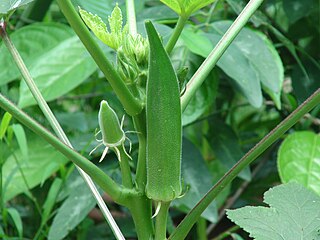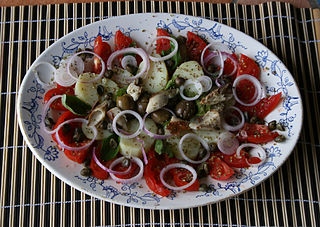| Pomodorino di Manduria | |
|---|---|
 | |
| Tomato (Solanum lycopersicum) | |
| Color | Red |
Pomodorino di Manduria is an ecotype of tomato typical of Manduria, a city in the province of Taranto. In the local dialect, it is also called "pummitoru paisanu".
| Pomodorino di Manduria | |
|---|---|
 | |
| Tomato (Solanum lycopersicum) | |
| Color | Red |
Pomodorino di Manduria is an ecotype of tomato typical of Manduria, a city in the province of Taranto. In the local dialect, it is also called "pummitoru paisanu".
Tomatoes are used in many Apulian traditional dishes, such as friselle or some typical recipe with pasta, meat and fish. The region hosts at least four traditional varieties of tomato.
These tomatoes are cultivated in little plots of land (1/2–2 hectares). They are sown in March and harvested from the second half of June to the first days of September. This ecotype does not need any trimming or pruning operation. The fruit weight is between 10 and 25 grams.
From some researches, it has been discovered that this ecotype is very resistant to the tomato spotted wilt orthotospovirus (TSWV) and with a graft that this tolerance is also transmitted to other varieties. [1] [2]
This table is about dried tomatoes in oil (for 100 grams).
| Water | Protein | Fat | Carbohydrate | Fiber | Energy Value |
|---|---|---|---|---|---|
| 57 | 5 | 14 | 17 | 5 | 214 kcal [3] |
Pomodorino di Manduria is grown in Manduria and Maruggio and, to a lesser extent, also in Sava, Avetrana and Lizzano. These cities and villages are located in deep loamy territories called Terre ti patuli. Near the Ionian Sea in the areas of San Pietro in Bevagna and Campomarino, the tomatoes are cultivated without the need for irrigation, while in the inland called "Terre rosse", two-three irrigation operations are needed in June.
Tomatoes are eaten fresh during summer with friselle or in salads with the barattiere di Manduria. Another use is for the production of the homemade tomato sauce or for making the dried tomatoes in oil. The main typical recipe is the "Jatedda", a salad with fresh tomatoes, garlic, "Terra d'Otranto" extra-virgin olive oil, salt, capers and oregano; usually it is served with slices of homemade dry bread.
The Italian Ministry of Agricultural, Food and Forestry Policies has recognised pomodorino di Manduria as prodotto agroalimentare tradizionale (PAT) of Apulia.

Mozzarella is a semi-soft non-aged cheese prepared by the pasta filata ('stretched-curd') method with origins from southern Italy.

Pasta is a type of food typically made from an unleavened dough of wheat flour mixed with water or eggs, and formed into sheets or other shapes, then cooked by boiling or baking. Pasta was traditionally only made with durum, although the definition has been expanded to include alternatives for a gluten-free diet, such as rice flour, or legumes such as beans or lentils. While Asian noodles are believed to have originated in China, pasta is believed to have independently originated in Italy and is a staple food of Italian cuisine, with evidence of Etruscans making pasta as early as 400 BCE in Italy.

Passiflora edulis, commonly known as passion fruit, is a vine species of passion flower native to southern Brazil and Peru. It is cultivated commercially in tropical and subtropical areas for its sweet, seedy fruit. The fruit is a pepo, a type of berry, round to oval, either yellow or dark purple at maturity, with a soft to firm, juicy interior filled with numerous seeds. The fruit is both eaten and juiced, with the juice often added to other fruit juices to enhance aroma.

The zucchini, courgette or baby marrow is a summer squash, a vining herbaceous plant whose fruit are harvested when their immature seeds and epicarp (rind) are still soft and edible. It is closely related, but not identical, to the marrow; its fruit may be called marrow when mature.

Manduria is a city and comune of Apulia, Italy, in the province of Taranto. With c. 32,000 inhabitants (2013), it is located 35 kilometres (22 mi) east of Taranto.

Okra, Abelmoschus esculentus, known in some English-speaking countries as lady's fingers, is a flowering plant in the mallow family native to East Africa. It has edible green seed pods. Cultivated in tropical, subtropical, and warm temperate regions around the world, okra is used in the cuisines of many countries.

Cypriot cuisine is the cuisine of the island of Cyprus, shared by both Greek Cypriots and Turkish Cypriots.

Caprese salad is an Italian salad, made of sliced fresh mozzarella, tomatoes, and sweet basil, seasoned with salt, and olive oil. It is usually arranged on a plate in restaurant practice. Like pizza Margherita, it features the colours of the Italian flag: green, white, and red. In Italy, it is usually served as an antipasto (starter), not a contorno, and it may be eaten any time of day. The caprese salad is one form of a caprese dish; it may also be served as a caprese pizza, pasta, or sandwich.

Neapolitan cuisine has ancient historical roots that date back to the Greco-Roman period, which was enriched over the centuries by the influence of the different cultures that controlled Naples and its kingdoms, such as that of Aragon and France.

Sun-dried tomatoes are ripe tomatoes that lose most of their water content after spending a majority of their drying time in the sun. These tomatoes are usually pre-treated with sulfur dioxide or salt before being placed in the sun in order to improve colour and appearance. Typically, tomatoes spend 4–10 days in the sun in order for the sun-drying process to be complete. Cherry tomatoes will lose 88% of their initial (fresh) weight, while larger tomatoes can lose up to 93% during the process. As a result, it takes anywhere from 8 to 14 kilograms of fresh tomatoes to make a single kilogram of sun-dried tomatoes.

Venetian cuisine, from the city of Venice, Italy, or more widely from the region of Veneto, has a centuries-long history and differs significantly from other cuisines of northern Italy, and of neighbouring Austria and of Slavic countries, despite sharing some commonalities.

Cappon magro is an elaborate Genoese salad of seafood and vegetables over hardtack arranged into a decorative pyramid and dressed with a rich sauce.

The traditional cuisine of Abruzzo is eclectic, drawing on pastoral, mountain, and coastal cuisine. Staples of Abruzzo cuisine include bread, pasta, meat, fish, cheese, and wine. The isolation which has characterized the region for centuries has ensured the independence of its culinary tradition from those of nearby regions. Local cuisine was widely appreciated in a 2013 survey among foreign tourists.

Middle Eastern cuisine or West Asian cuisine includes a number of cuisines from the Middle East. Common ingredients include olives and olive oil, pitas, honey, sesame seeds, dates, sumac, chickpeas, mint, rice and parsley, and popular dishes include kebabs, dolmas, falafel, baklava, yogurt, doner kebab, shawarma and mulukhiyah.

Pizza marinara, also known as pizza alla marinara, is a style of pizza in Neapolitan cuisine seasoned with only tomato sauce, extra virgin olive oil, oregano and garlic. It is supposedly the oldest tomato-topped pizza.

The Pantesca salad or Pantelleria salad is a typical dish of the island of Pantelleria.

Apulian cuisine consists of the cooking traditions and practices of the region of Apulia in Italy. Starting from the Middle Ages the permanent residence of the nobility in the region gradually declined, which caused the disappearance of their noble cuisine over time. As the common people suffered from poverty, their culinary tradition adapted to use cheap and simple foods. Bread, vegetables and pasta have the leading role in the cuisine. Fruits, fish and wine are consumed frequently as well, but meat plays a minor role. The food of Apulia is known as a prime example of cucina povera or 'cuisine of the poor', characterizing its simplicity rather than its quality. Moreover, the simple dishes allow the quality of their local and seasonal ingredients to take center stage.

The capuliato or capuliatu is a traditional condiment of Sicilian cuisine based on dried tomatoes, linked, in particular to the territory of the Vittoria Plain, in free municipal consortium of Ragusa. The original name is capuliato, meaning 'minced'.

The cuisine of Basilicata, or Lucanian cuisine, is the cuisine of the Basilicata region of Italy. It is mainly based on the use of pork and sheep meat, legumes, cereals and vegetables, with the addition of aromas such as hot peppers, powdered raw peppers and horseradish. The local gastronomy is, for historical-cultural reasons, typically peasant, based on simple recipes and on the culture of reuse, in particular of meat and bread.